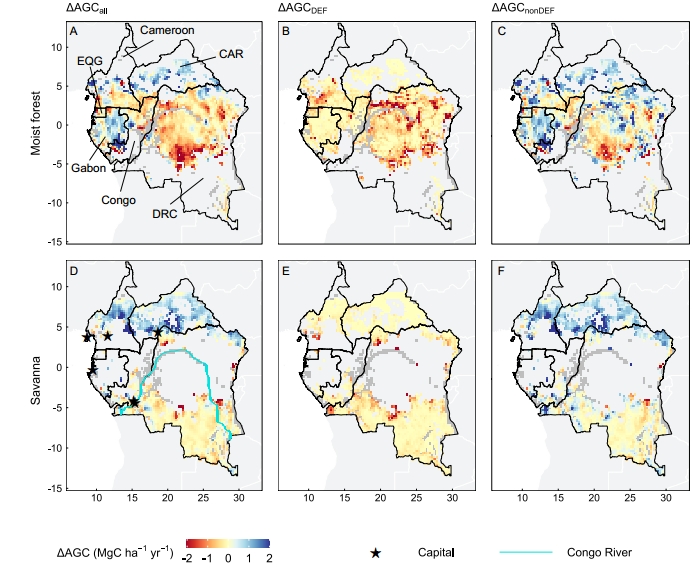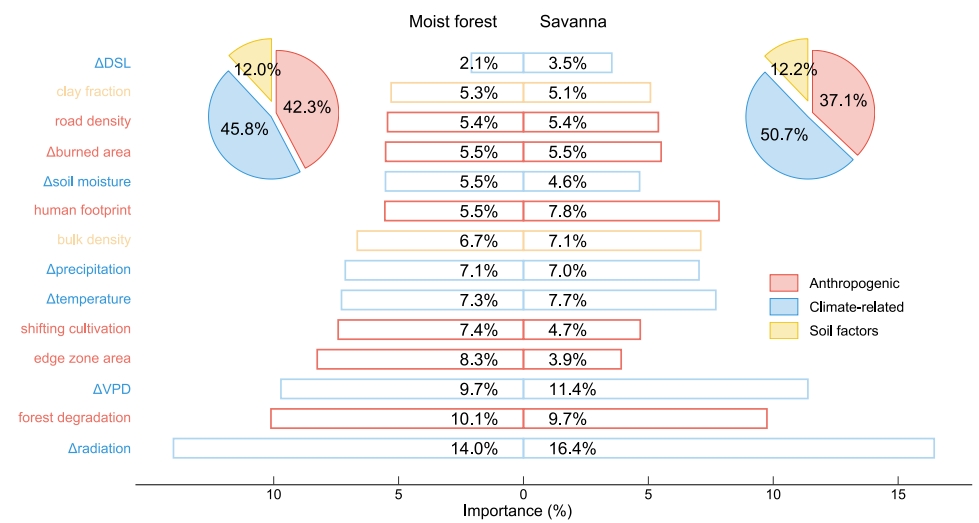Central Africa, boasting the second largest tropical moist forests and a large area of savannas, plays an important role in the global terrestrial ecosystem carbon cycle. Over the past few decades, however, deforestation and degradation in this region have produced a lot of carbon emissions, but at the same time, vegetation growth and restoration will give rise to carbon sequestration, so the dynamic change of carbon cycle in this region has always been a research hotspot in the field. Nevertheless, due to the lack of large-scale long-term direct observation data and time series data of aboveground biomass carbon (AGC), the driving mechanism of natural and human factors on the change of vegetation carbon storage in Central Africa is still unclear.
Associate Professor Li Wei’s Research Group of the Department of Earth System Science (DESS), Tsinghua University, in conjunction with several other research institutions at home and abroad, conducted research on the spatio-temporal changes of AGC in Central Asia and their contributing factors. First, based on L-VOD data and several sets of reference data of aboveground biomass density of vegetation, the AGC changes of the six Central African countries: Cameron, Central African Republic (CAR), DRC, Equatorial Guinea (EQG), Gabon, and Republic of the Congo (Congo) were estimated. Furthermore, the importance and impact of climate-related variables, anthropogenic variables and soil variables on carbon storage changes were analyzed by machine learning algorithm. It was found in the study that during 2010–2019, deforestation induced a gross AGC loss of 102.2 Tg C year−1, which was counterbalanced by an AGC increase of 116.9 Tg C year−1, leading to a net gain of 14.6 Tg C year−1. A large AGC increase was found in the northern savannas. It is found that the most important contributing factor for the AGC change in Central Africa is climate-related variables, followed by anthropogenic variables, while the impact of soil factors is the smallest. The research results are of important scientific significance for the formulation of future forest management and conservation policies, balancing nature reserves and socio-economic development, and mitigating global climate change.

Figure 1. Spatial distributions of AGC changes for the period 2010–2019. (A)–(C) are for moist forests, and (D)–(F) are for savannas. (A) and (D) show the total changes, (B) and (E) show ΔAGC due to deforestation, and (C) and (F) show non-deforestation changes.

Figure 2. Relative importance of variables in explaining the spatial variations of non-deforestation AGC changes using a gradient-boosting model
The above research results have been recently published in the form of a paper titled “Central African biomass carbon losses and gains during 2010-2019” in One Earth. Doctoral student Zhao Zhe of the DESS, Tsinghua University is the first author of the paper, and Associate Professor Li Wei is the corresponding author. Co-authors include Professor Philippe Ciais and Dr. Xu Yidi of Laboratoire des Sciences du Climat et de l’Environnement (LSCE), Professor Jean-Pierre Wigneron, Dr. Li Xiaojun and Dr. Wang Mengjia of Université de Bordeau, Dr. Maurizio Santoro of Gamma Remote Sensing, Professor Martin Brandt and Professor Rasmus Fensholt of the University of Copenhagen, Professor Fritz Kleinschroth of ETH Zurich, Professor Simon L. Lewis of the University of Leeds, Researcher Jerome Chave of Laboratoire Evolution and Diversité Biologique, Professor Nadine Laporte of Northern Arizona University, Researcher Denis Jean Sonwa of the Center for International Forestry Research (CIFOR), Researcher Sassan S. Saatchi of Jet Propulsion Laboratory, California Institute of Technology, Professor Fan Lei of Southwest University, Dr. Yang Hui of Max Planck Institute for Biogeochemistry, and doctoral student Zhu Lei and Dr. He Jiaying of the DESS, Tsinghua University. This study was supported by the Yunnan Major Scientific and Technological Projects, the National Natural Science Foundation of China, and the National Key R&D Program of China, among others.
Full-text link: https://doi.org/10.1016/j.oneear.2024.01.021
Written by Zhao Zhe
Edited by Wang Jiayin
Reviewed by Zhang Qiang